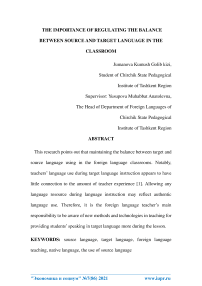The importance of regulating the balance between source and target language in the classroom
Автор: Jumanova K.G.
Журнал: Экономика и социум @ekonomika-socium
Рубрика: Основной раздел
Статья в выпуске: 7 (86), 2021 года.
Бесплатный доступ
This research points out that maintaining the balance between target and source language using in the foreign language classrooms. Notably, teachers’ language use during target language instruction appears to have little connection to the amount of teacher experience [1]. Allowing any language resource during language instruction may reflect authentic language use. Therefore, it is the foreign language teacher’s main responsibility to be aware of new methods and technologies in teaching for providing students’ speaking in target language more during the lesson.
Source language, target language, foreign language teaching, native language, the use of source language
Короткий адрес: https://sciup.org/140260673
IDR: 140260673
Список литературы The importance of regulating the balance between source and target language in the classroom
- Krulatz, A., Neokleous, G., & Henningsen, F. V. (2016). Towards an understanding of target language use in the EFL classroom: A report from Norway. International Journal for 21st Century Education, 3, 137 152. https://doi.org/10.21071/ij21ce.v3iSpecial.5713
- Jenkins, J. (2015). Repositioning English and multilingualism in English as a lingua franca. Englishes in Practice, 2(3), 49 85. https://doi.org/10.1515/eip 2015 0003
- Canagarajah, S. (2013). Translingual practice: Global Englishes and cosmopolitan relations. New York, NY: Routledge.
- Macaro, E. (2001). Analyzing student teachers’ codeswitching in fore Ign language classrooms: Theories and decision making . Modern Language Journal, 85, 531 548. https://doi.org/10.1111/0026 7902.00124
- Moore, P. J. (2013). An emergent perspective on the use of the first language in the English as a foreign language class room . Modern LanguageJournal,97,239 253.https://doi .org/10.1111/j.1540 4781.2013.0 4
- Seltzer, K. (2019). Reconceptualizing “home” and “school” language: Taking a critical translingual approach in the English classroom. TESOL Quarterly. Advance online publ ication. https://doi.org/10.10 on 02/tesq.530
- Krulatz, A., Neokleous, G., & Henningsen, F. V. (2016). Towards an understanding of target language use in the EFL classroom: A report from Norway. International Journal for 21st Century Education, 3, 137 15 2. https://doi.org/10.21071/ij21ce.v3iSpecial.5713
- Polio, C., & Duff, P. (1994). Teachers language use in university foreign language classrooms: A qualitative analysis of English and target language alternation.Modern Language Journal, 78, 313 326. https://doi.org/10.1111/j.1540 4781.1994.tb02045.x
- Beiler, I. R. (2019). Negotiating multilingual resources in English writing instruction for recent immigrants to Norway. TESOL Quarterly. Advance online publication. https://doi.org/10.1002/tesq.53
- De wilde, J. (2019). Forord [Preface]. In O. Garc ı a & Li Wei, Transspraking: Sprak,tospraklighet og opplæring [Translanguaging: Language, bilingualism and education]. Oslo, Norway: Cappelen Damm Akademisk.
- Cenoz, J., & Gorter, D. (2017). Minority languag es and sustainable translanguaging: Threat or opportunity? Journal of Multilingual and MulticulturalDevelopment,38,901 912 .https://doi.org/10.1080/01434632.2017.1284855
- Jumanova K.G, The Impact of Extracurricular Work On Students Learning Proces s. I nternational Journal of Academic Pedagogical Research (IJAPR) ISSN: 2643 9123 Vol. 5 Issue 4, April 2021, Pages: 134 135


